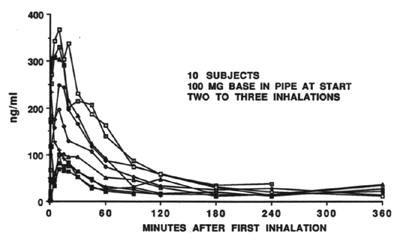
Figure 1. Plasma Levels of cocaine after smoking
Originally published in (eds. C. Nora Chiang, Ph.D., Richard L. Hawks, Ph.D.) NIDA Research Monograph 99 (Research Findings on Smoking of Abused Substances), 1990, p. 30-41.
Reese T. Jones, M.D.
Drug Dependence Research
Center
Langley Porter Psychiatric Institute
University of California, San
Francisco
San Francisco, California 94143
Smoking crack is smoking cocaine. Why would people go to the trouble of smoking cocaine when they can so easily snuff it, take it orally, or inject it parenterally? For many of the same reasons that nicotine is pleasurable to a tobacco addict and is so much more addicting when smoked in the form of tobacco cigarettes than when snuffed or chewed, so smoking the alkaloid cocaine is even more addicting than use by other routes (Benowitz, this volume). For similar reasons, most cannabis-dependent people choose to smoke marijuana or hashish even though tetrahydrocannabinol (THC) is psychoactive by oral ingestion. Of course, cocaine, nicotine and THC pharmacology differ, but the aspects of their pharmacology that lead to preference for the smoked route of ingestion as well as some of the consequences of that choice are similar. If what is known of other inhaled drugs is kept in mind (Benowitz, this volume), it may be easier to understand certain consequences of cocaine smoking and, perhaps more important, to design proper experiments to study cocaine smoking.
Smoking cocaine has become popular only in recent years, mostly in North America and some Latin American countries (Jeri 1984; Siegel 1985). Like most current patterns of psychoactive drug use, smoking cocaine was not completely unknown to the ancients. For example, in the United States, during the early part of this century, the Parke, Davis & Company pharmaceuticals listed, among other dose forms of coca and cocaine, coca cheroots and coca cigarettes. The Parke, Davis coca cigars and cigarettes probably contained between 0.5 and 1.0 percent cocaine and were recommended for therapeutic use. A similar product known as the Coca Leaf Ball was advertised in England during the same period with the suggestion that "families, mothers and children" would benefit from the therapeutic effects of smoked coca. Famous people from England and Europe testified as to its effectiveness and must have engaged in cocaine smoking, although there is no indication that addiction to coca smoking was common. In some ways, smoking coca leaf might be analogous to smoking tobacco or cannabis leaf in that a relatively small concentration (0.5 to 2%) of active substance (cocaine, nicotine, THC) is contained in a relatively large amount of plant material. Smoking coca leaf never became as popular as smoking tobacco leaf. Chewing coca leaf remained common only in relatively isolated groups, where it had long been part of their culture (Hanna and Hornick 1977).
In more recent times, smoking cocaine in the form of a crude plant extract sometimes called paste and containing about 80 percent cocaine base became popular in Peru and in adjacent countries (Almeida 1978; Jeri 1984; Flores 1986). Up to then, both in medical applications and illicitly, the water-soluble salt, usually cocaine hydrochloride, was the form more commonly used. Currently in North America, a readily available and widely discussed form is cocaine base, usually converted from the cocaine salt by mixing cocaine hydrochloride and a solution containing an excess of sodium bicarbonate (usually baking soda) and heating and evaporating off the fluid. This leaves mostly cocaine base in a bicarbonate crystalline mixture. In most large cities in the United States, the availability of illicit ready-to-smoke base facilitates smoking cocaine. Cocaine base melts at a much lower temperature than the salt (about 80°C instead of 180°) and then boils, producing an inhalable aerosol (Snyder et al. 1988; Wood, this volume). Whether forces of the illicit marketplace led to changes in cocaine chemistry and packaging or whether the availability of high concentration, relatively pure cocaine base shaped the market forces to increase consumer demand is not entirely clear. In any case, a cocaine user who chooses to smoke can now obtain material containing close to 100% cocaine rather than using coca plant material containing 1% of cocaine base. Consider the likely consequences if THC was readily available to add to smoking devices or if nicotine addicts began adding additional nicotine to tobacco cigarettes. Although not a perfect analogy, considering such events may help put cocaine smoking in perspective.
A variety of devices are used for cocaine smoking: pipes of all sorts, or cigarettes made of admixtures of cocaine base with tobacco, with marijuana or other plant material. The use of nonstandardized smoking devices contribute to a situation similar to that during the early days of cannabis-smoking research. When programs of controlled laboratory experiments with smoked cocaine are begun, it is not obvious what the typical laboratory smoking conditions should be, what constraints on smoking behavior are proper, and what physical and chemical considerations will maximize the likelihood that laboratory experiments will be relevant to the real world of illicit smoked cocaine, but will maintain adequate research subject safety. In contrast, a researcher of tobacco smoking has the advantages of great standardization of dose, dose form, and delivery systems developed by the tobacco industry. Even with that information, smoking behavior procedural issues in tobacco-smoking research, particularly dose regulation, are complex and not all are resolved (Diding 1987; Kozlowski et al. 1982).
Relatively little has been published describing the human pharmacology of cocaine smoking under controlled or semicontrolled laboratory conditions (Perez-Reyes et al. 1982; Jeffcoat et al. 1989). Experiments, where experienced volunteers smoked from a glass apparatus heated to 260°C and containing 50 mg of cocaine base, demonstrated the rapid increase in plasma cocaine levels during smoking as compared to intravenous (IV) cocaine administration, that would be expected from what is known of the smoking process with nicotine and cannabis (Benowitz, this volume; Perez-Reyes, this volume). Other than more rapid onset, the resulting cardiovascular and psychologic changes were not unlike those seen after equivalent IV or nasal cocaine doses. Other experiments with monkeys (Siegel et al. 1976) and with smokers of crude extracts of cocaine often called paste noted a generally similar pattern of effect (Paly et al. 1982).
Laboratory studies with any smoked drug present great methodologic challenges to the investigator. Proper pharmacologic studies must involve control of dose or at least accurate specification of dose actually absorbed. The nature of smoking behavior makes dose difficult to regulate and, under many conditions, difficult even to estimate. Although animals can be made to smoke under some conditions (Siegel et al. 1976), they seem reluctant to smoke the way humans do; thus human studies are necessary.
Cocaine may present special problems that have not been important in tobacco or cannabis smoking research. The rate of cocaine degradation is very temperature dependent, hence, subject to variability because of smoking apparatus design and variation in conditions. Temperature in most cocaine-smoking devices varies with air flow. Air flow, in the case of humans smoking under natural conditions, depends on both puff and inhalation volumes and duration. The importance of puff and inhalation volume in determining dose is well recognized by tobacco and cannabis researchers (Herning et al. 1983; Benowitz 1986). How to control or regulate dose in psychopharmacologic studies involves compromises, and optimal solutions are not evident yet. When cocaine is smoked, the amount of cocaine pyrolyzed to other compounds will be related to the temperature in the smoking device. The temperature, in turn, will be related to the smoker's behavior, making for a complex equation to determine drug delivery.
When researching nicotine smoking, an investigator can depend on a degree of industry- and government-derived standardization of the smoking devices (cigarettes, pipes, etc.). In marijuana smoking research over the years, some consensus has developed as to smoking material and apparatus, at least in the laboratory. Cocaine smoking research, however, is nowhere near that point. The usual and expected "natural" or typical pattern (or more likely, the range of patterns) of cocaine smoking is not at all established; hence, the relevance of laboratory paradigms is still open to question. For example, typical puff and inhalation parameters obtained during relatively unconstrained cocaine smoking have not been determined as they have with nicotine and with marijuana.
In experiments trying to describe the pharmacology of cocaine smoking, we have attempted to control some aspects of smoking behavior but, in these beginning experiments, left options open for the subjects, all of whom claimed to be experienced cocaine smokers. What is apparent in the laboratory data we have collected thus far is great variability; both variability in cocaine smoking behavior and, under conditions where smoking behavior parameters are to some extent constrained, considerable variability in cocaine plasma levels and effects.
For example, in figure 1 the plasma concentrations are shown from 10 research different subjects smoking cocaine base under similar conditions. Peak venous cocaine levels range from less than 100 ng/ml to approximately 500 ng/ml with considerable variability in time of peak as well. These cocaine smokers were allowed to take one or two and occasionally three inhalations spaced 1 minute apart from an electrically heated 1-liter glass flask beginning about 45 seconds after 100 mg of finely powdered cocaine base was dropped into the flask. At that time the cocaine base had melted, and a fine white aerosol was forming in the flask. The clear puddle of melted cocaine at the bottom of the flask was just beginning to yellow in the process that would turn it into a black tarry mass just a few minutes later. The temperature of the glass surface at the bottom of the flask was at a 260°C.

Figure 1. Plasma Levels of cocaine after smoking
The variation in plasma levels is contrasted with those from the same subjects given cocaine IV at a dose of 0.6 mg/kg of body weight injected by infusion pump over 1 minute (figure 2). Perhaps noteworthy is the considerable variability in peak plasma levels of cocaine even with controlled IV administration. Variability in venous plasma levels is not unexpected with a rapidly distributed, relatively rapidly metabolized drug, although it should give pause for thought for those attempting to predict precise relationships between drug effect and blood levels from a particular cocaine dose. It should be kept in mind that, particularly by the smoked route, arterial level of cocaine is more likely to be a much better indicator of brain levels than is venous blood level. As is the case with nicotine smoking, venous cocaine levels will underestimate brain levels.
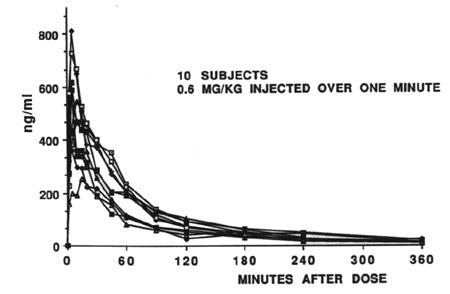
Figure 2. Plasma Levels of cocaine: IV
administration
When the mean plasma cocaine levels after IV or smoked doses are compared to those of nasal or oral doses of cocaine hydrochloride, reasons for some of the appeal of the smoked route are evident (figure 3). The time of peak level is significantly earlier after dose in the smoked or IV route. Similarly, the time of peak subjective effect is earlier by the smoked route (figure 4). Figure 4 illustrates the peak subjective-high rating in which zero is defined as a normal, sober state and 100 is as intoxicated as ever experienced after cocaine administration.
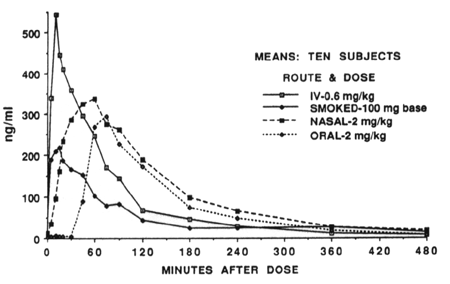
Figure 3. Plasma Levels of cocaine
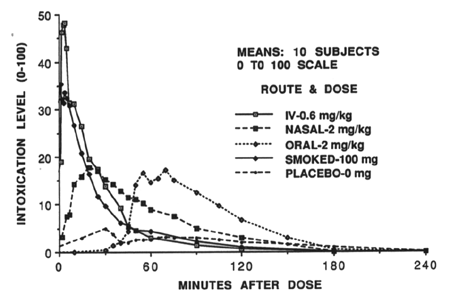
Figure 4. Plasma Levels of cocaine: Subjective high
ratings
Why should a shorter interval to peak effect be important to a drug user? Probably because neuroadaptation (tolerance) to many psychoactive drug effects is a rapidly developing process better timed in seconds and minutes than in hours or days. The slower any drug effect arises, other things being equal, the less intense the effect, because tolerance to the effect is in a real sense developing concurrently with the appearance of the drug effect.
Rapidly developing tolerance to cocaine is demonstrated in a hysteresis plot of plasma level versus subjective intoxication rating in figure 5. If little or no tolerance (neuroadaptation) developed over the 4 hours summarized in figure 5, the plot following the ascending and descending phases of the time/ plasma level function would be more or less a straight line. One index of the magnitude of tolerance is the divergence of those ascending and descending functions (Holford and Sheiner 1981). Note that the subjects had the option of rating their level of dysphoria with a minus value, and some did so as the cocaine effects wore off. Figure 6 shows the clockwise hysteresis plots of subjective intoxication levels vs. cocaine concentrations in plasma after smoking cocaine and after an IV dose (0.6 mg/kg) in the same 10 research patients whose time vs. concentration data are in figures 1 and 2. Quantitative comparisons between the smoking and the IV hysteresis loops involve many assumptions, but a variety of semiparametric methods seem useful for a quantitative pharmacokinetic-pharmacodynamic descriptive model (Verotta et al. 1989). The similarity to the rapid tolerance that develops to many effects of nicotine is striking (Benowitz, this volume).
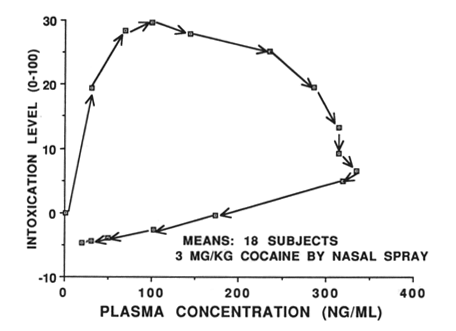
Figure 5. High vs. cocaine levels in plasma after nasal
cocaine (20% solution)
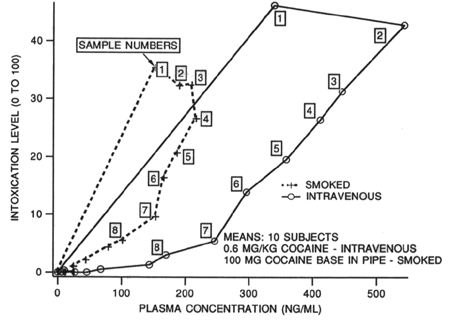
Figure 6. High vs. cocaine levels in plasma after IV and
smoked cocaine
Assuming that most of cocaine's subjective effects are related to its brain effects, the more rapid transit time from lung to brain (5 to 10 seconds) after inhalation of cocaine smoke would more likely provide a steeper and higher gradient of cocaine brain levels than could oral, nasal, or even intravenous administration. Table 1 summarizes the magnitude and time of some peak effects after cocaine given to the same 10 experienced cocaine users by various routes, in balanced order, with about 3 days between doses.
| Route (Dose) | ||||
|---|---|---|---|---|
| IV (0.6 mg/kg) |
Smoked* (0.4 mg/kg) |
Nasal (2 mg/kg) |
Oral (2 mg/kg) | |
| Heart Rate Increase, BPM (time to max, minutes) |
46 (10) | 32 (2) | 26 (40) | 20 (55) |
| Systolic BP Increase, (time to max) |
28 (10) | 32 (2) | 24 (25) | 19 (70) |
| Diastolic BP Increase, (time to max) |
16 (10) | 22 (1) | 11 (25) | 14 (75) |
| Pupil Diameter Increase, mm (time to max) |
0.8 (4) | 1.1 (5) | 0.6 (45) | 0.5 (90) |
| Skin Temperature Decrease, °C (time to max) |
-2.8 (30) | -1.8 (20) | -4.7 (30) | -5.1 (75) |
| Subjective High 1-100 Scale (time to max) |
48 (4) | 35 (1) | 18 (20) | 18 (70) |
That both the peak venous plasma cocaine levels and the peak intoxication
levels are greater when cocaine is taken IV route, compared with the smoked
route, might suggest more advantage to the IV route. To make proper comparisons
between smoked dose and effect, the dose actually delivered to the
individual subject must be considered. Therein lies one of the problematic
considerations in human research with any smoked material. Traditional
procedures to characterize bioavailability do not precisely fit drug smoking
situations. How much of that 100 mg of cocaine base placed in the pipe actually
was absorbed by the subject?
On average, 70 (range 10 to 85) mg of the cocaine base remained in the flask and was recrystallized on the surface of the tubing after smoking. Thus, on average, a maximum of about 30 mg of cocaine base was delivered to the mouth of the inhaling research subject. An indeterminant amount of cocaine was broken down to poorly characterized pyrolytic products in the smoking process. The biological activity of those products is not well established. Thus, in fact, considerably less than 30 mg of cocaine base was probably delivered to the mouth of the inhaling research subject. Our electrically heated 1-liter flask was, of course, a rather special and not a typical free base pipe, but experience with cocaine pipes brought into the laboratory by research subject volunteers is similar. Much, perhaps even most, of the cocaine base placed in the pipe does not reach the mouth of the smoker. How much cocaine aerosol actually reaches lung alveoli depends on heating conditions, air flow, number of inhalations, and other things determined largely by the smoker who only reluctantly yields control to the researcher, if cocaine smoking is like other smoking behavior.
If all the cocaine not remaining in the pipe was delivered to the lung alveoli and thus probably completely absorbed, cocaine dose could be better estimated. However, pyrolysis occurs at variable rates during the smoking process. Although breakdown is not completely quantified yet, we have strong evidence that anhydroecgonine methyl ester is one of the major breakdown products under our smoking conditions. Thus, under the smoking conditions leading to the plasma levels in figures 1 and 2, only a small fraction of the 100 mg of cocaine base in the smoking apparatus actually was delivered to the alveolar surface, where rapid absorption is most likely.
The relative percentages of cocaine base delivered, what remains in the pipe, and what is destroyed vary greatly with the smoking conditions encountered with various smoking apparatus. The 10 subjects in the experiment discussed claimed to be experienced and reasonably confirmed cocaine base smokers, exhibited a varied repertoire of smoking styles ranging from very big puffs with very little and brief inhalation to, at the other extreme, maximum and rapid forced inhalation and valsalva maneuver with little or no intermediate puff behavior. The variability in smoking behavior we have encountered amongst cocaine smokers is much greater than commonly seen in otherwise similar groups of marijuana or tobacco smokers.
Inferring what is likely to be happening in the real world of crack smoking from laboratory studies is risky until the range of possible cocaine-smoking behavior in real-life situations is better understood and better described. Much can be gleaned from what we know of nicotine and THC smoking. The principles that guide the smoking of those drugs and the unresolved problems of researching nicotine and THC smoking apply to cocaine as well.
Originally published in NIDA Research Monograph 1990, 99:30-41.
REFERENCES
Almeida, M. Natural history of dependence of cocaine basic paste. Rev Neuropsiquiatr, 41: 44-55, 1978.
Benowitz, N.L. Clinical pharmacology of nicotine. Ann Rev Med, 37: 21-32, 1986.
Diding, N. Machine smoking results compared to human uptake of cigarette smoke. Int J Clin Pharmacol Ther Toxicol, 25: 143-147, 1987.
Flores, A.R. Drug abuse problems in countries of the Andean subregion. Bull Narc, 38: 27-36, 1986.
Hanna, J.M.and Hornick, C.A. Use of coca leaf in southern Peru: adaptation or addiction. Bull Narc, 29: 63-74, 1977.
Herning, R.I.; Jones, R.T.; Benowitz, N.L.; and Mines, A.H. How a cigarette is smoked determines blood nicotine levels. Clin Pharmacol Ther, 33: 84-90, 1983.
Holford, N.H.G. and Sheiner, L.B. Understanding the dose-effect relationship: Clinical application of pharmacokinetic-pharmacodynamic models. Clin Pharmacokin, 6:429-453, 1981.
Jeffcoat, A.R.; Perez-Reyes, M.; Hill, J.M.; Sadler, B.M.; and Cook, C.E. Cocaine disposition in humans after intravenous injection, nasal insufflation (snorting), or smoking. Drug Metab Dispos, 17: 153-159, 1989.
Jeri, F.R. Coca-paste smoking in some Latin American countries: a severe and unabated form of addiction. Bull Narc, 36: 15-31, 1984.
Kozlowski, L.T.; Rickert, W.S.; Pope, M.A.; Robinson, J.C.; and Frecker, R.C. Estimating the yield to smokers of tar, nicotine, and carbon monoxide from the 'lowest yield' ventilated filter-cigarettes. Br J Addict, 77: 159-165, 1982.
Paly, D.; Jatlow, P.; Van, D.C.; Jeri, F.R.; and Byck, R. Plasma cocaine concentrations during cocaine paste smoking. Life Sci, 30: 731-8, 1982.
Perez-Reyes, M.; Di, G.S.; Ondrusek, G.; Jeffcoat, A.R.; and Cook, C.E. Free-base cocaine smoking. Clin Pharmacol Ther, 32: 459-465, 1982.
Siegel, R.K. New patterns of cocaine use: changing doses and routes. In Kozel, N.J., and Adams, E.H., eds. Cocaine Use in America: Epidemiolological and Clinical Perspectives. National Institute on Drug Abuse Research Monograph 61. DHEW Pub. No. (ADM) 85-1414. Washington, D.C.: Supt. of Docs., U.S. Govt. Print. Off., 1985. pp. 204-220.
Siegel, R.K.; Johnson, C.A.; Brewster, J.M.; and Jarvik, M.E. Cocaine self-administration in monkeys by chewing and smoking. Pharmacol Biochem Behav, 4: 461-467, 1976.
Snyder, C.A.; Wood, R.W.; Graefe, J.F.; Bowers, A.; and Magar, K. "Crack smoke" is a respirable aerosol of cocaine base. Pharmacol Biochem Behav, 29: 93-95, 1988.
Verotta, D.; Beal, S.L.; and Sheiner, L.B. Semiparametric approach to pharmacokinetic-pharmacodynamic data. Am J Physiol, 256(4 Part 2): R1005-1010, 1989.
ACKNOWLEDGMENTS
Supported in part by US Public Health Service grants DA00053, DA02829, DA04419, DA01696, and contract No. 271-87-8123.
AUTHOR
Reese T. Jones, M.D.
Professor of Psychiatry
Langley Porter Psychiatric
Institute
University of California, San Francisco
San Francisco,
California 94143